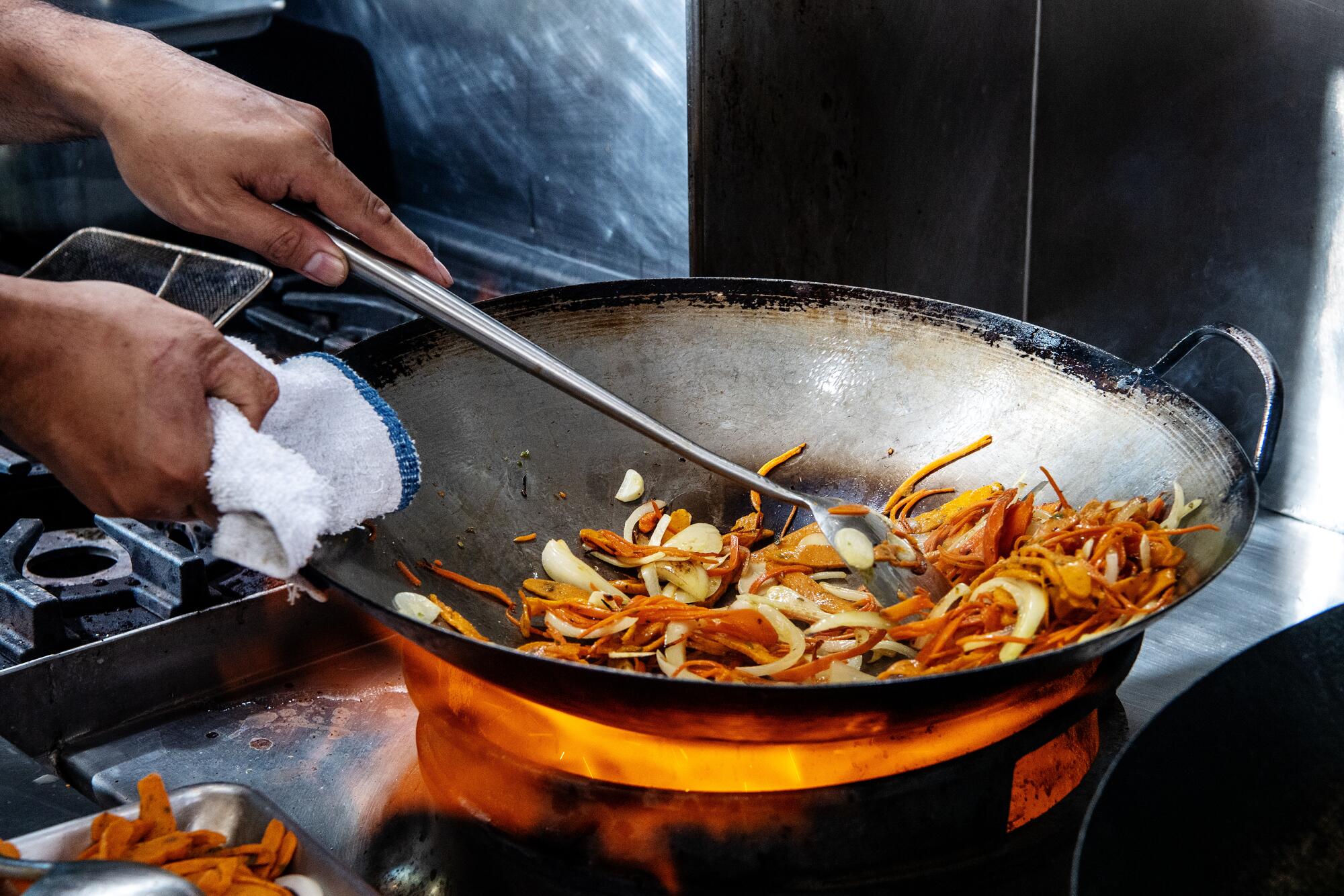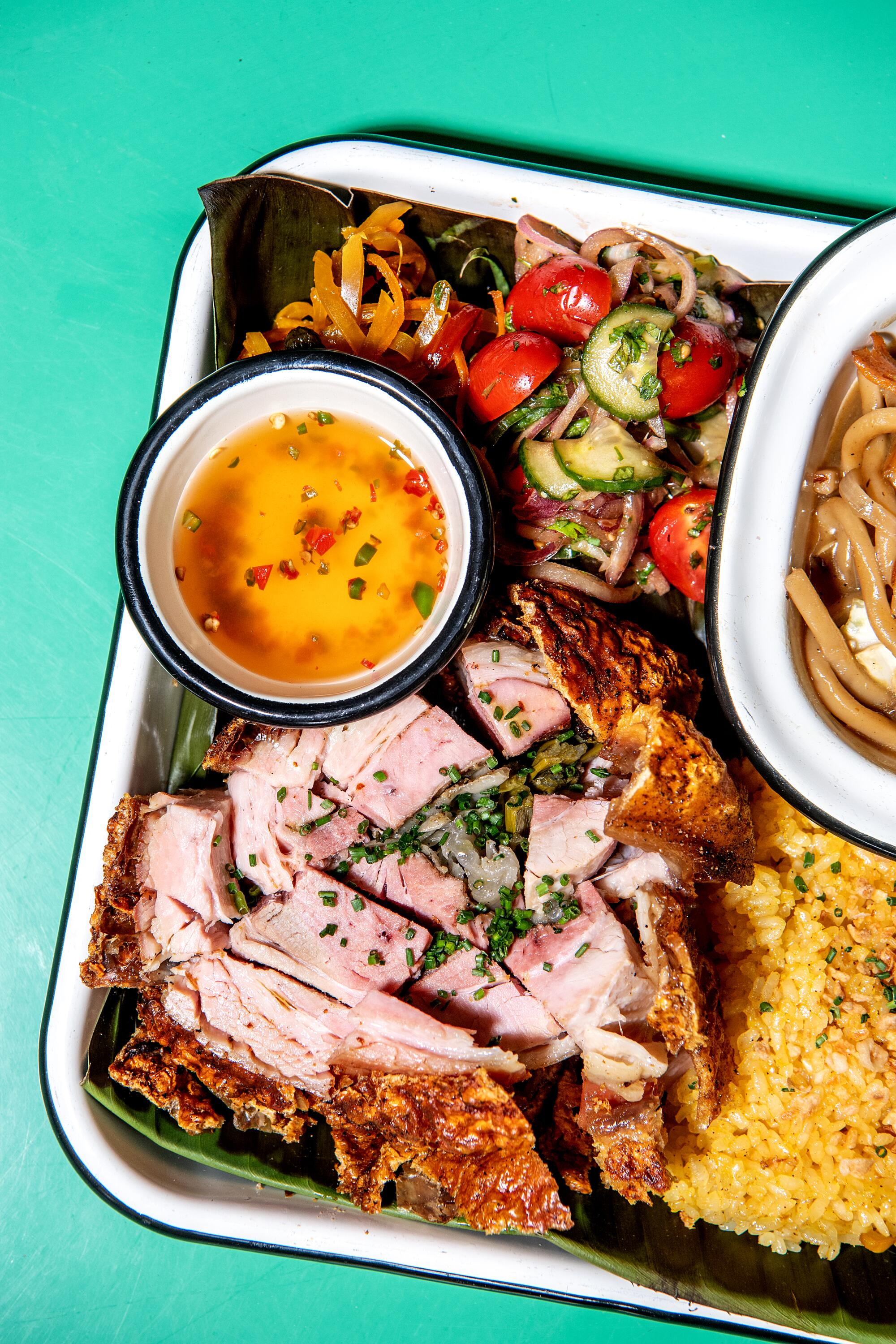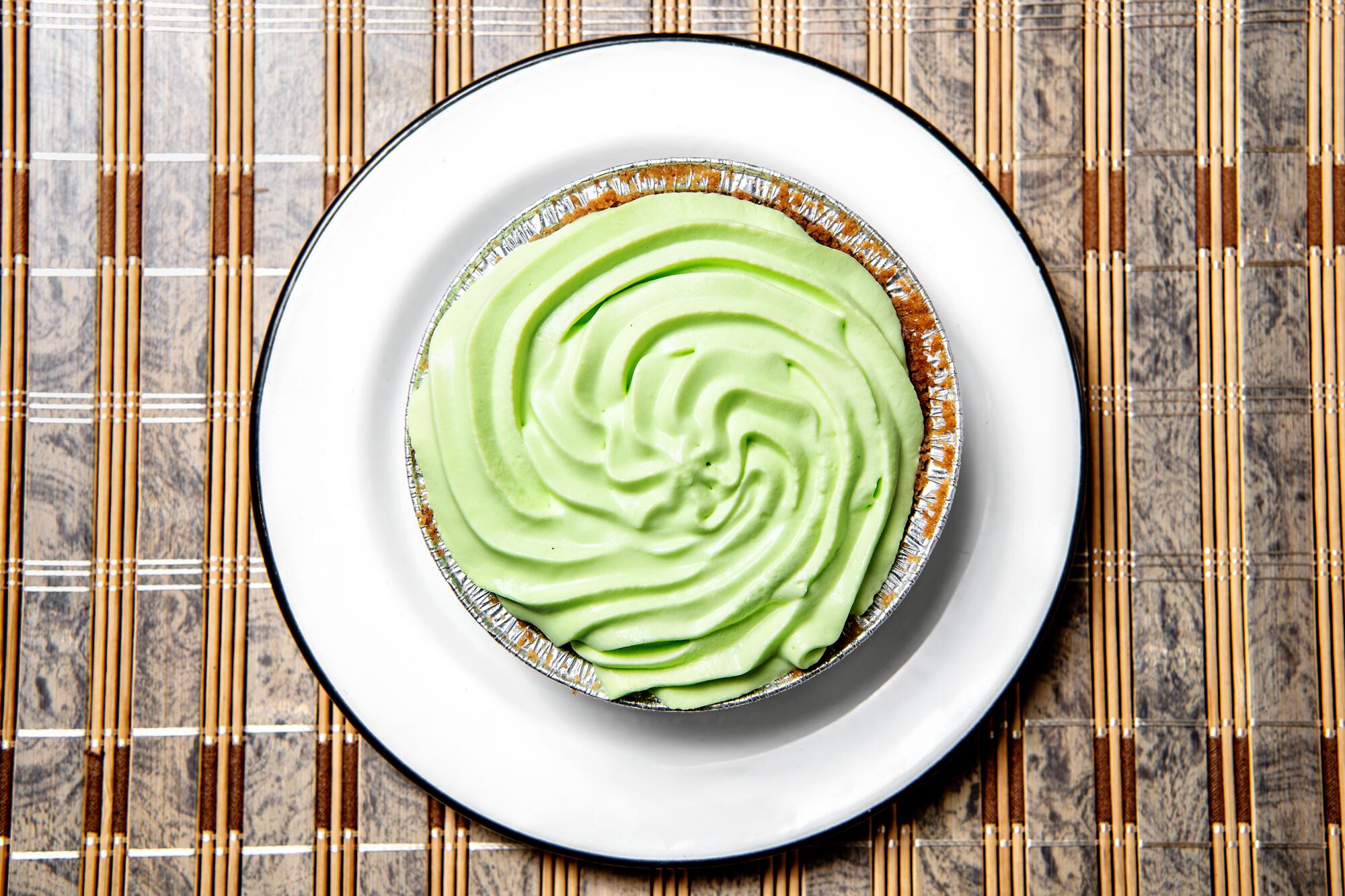
At Kuya Lord in Hollywood, Lord Maynard Lllera seamlessly transitions his delicious, personal Filipino cooking from pop-up to restaurant.
The first time I saw Lord Maynard Llera was in November 2020. He was masked and occupied by a shimmering-hot wok full of vegetables in a converted garage. He had transformed part of his home in La Cañada Flintridge into a separate kitchen for Kuya Lord, the takeout pop-up that he and his family ran during the pandemic.
Llera had approached the weekend project foremost as a COVID-era survival plan, but also as research and development for the restaurant he planned to open when the crisis subsided. While I watched him toss pancit chami (thick egg noodles) among slivered carrots and cabbage, his wife, Gigi Llera, brought out my order in large aluminum trays.

I drove home and pried off the lids. The pans’ contents — grilled chicken fragrant with wood and spice, roasted pork belly with visibly crackling skin, shell-on prawns in crab sauce, garlic rice stained with annatto oil and a wok-smoky tangle of pancit chami — had been arrayed over banana leaves in the spirit of kamayan, the communal meals of the Philippines usually eaten by hand.
Once on my plate, the flavors drifted between herbal subtlety and high-potency doses of sour, salt and fermented umami. The last decade had seen an ascendance of Filipino cuisine in restaurants locally and nationally. Llera stepped into the arena as a gripping new expressionist of Filipino cooking — a talent whose time had arrived.
Lasita in Chinatown’s Far East Plaza serves Filipino comfort foods and natural wines to match them.
Two years later, I’m watching Llera in action again. This time he multitasks behind the counter of his 5-month-old, 28-seat restaurant in the Melrose Hill section of Hollywood. He takes my order. He calls out dishes for his chefs to fire. The restaurant’s kitchen is in full view. He watches a new team member over his shoulder and lobs a few instructions her way while she tumbles vegetables and noodles in a wok larger than the one his garage could accommodate.


Kato was No. 1 on our last ranked list of the 101 best Los Angeles restaurants before COVID. Now it’s in a new high-design space at the Row DTLA.
This is the culmination of Llera’s deferred dream. He grew up in Lucena City, a port town in the Philippines’ fertile Quezon province, about 80 miles south of Manila. Settling in Los Angeles, home to the largest Filipino population outside the Philippines, he was the opening sous chef at Bestia and went on to become culinary director for the h.wood group. In 2019, the year he turned 40, he left to host pop-up dinners while planning his first restaurant.
He mostly goes by his middle name, Maynard, but friends like Ken Concepcion and Michelle Mungcal of Now Serving L.A. call him “Kuya Lord”; “kuya” is a Tagalog term of affectionate respect meaning older brother. It gave Llera the moniker for his place, even if a physical space took several years longer to open than he expected.
With satisfaction I settle at one of the communal tables and consider the food that soon arrives — how right it feels to eat this meal with the immediacy in which it was intended.

I go directly for the “lucenachon,” Llera’s nickname for a Filipino-inspired version of porchetta. He rolls pork belly into a cylinder, its center stuffed with lemongrass stalks, fennel fronds and spears of red onion. Carving through a ring of it reveals taut meat, lush fat and skin far glassier than I’d had previously, when the pork had steamed in a takeout container. Lechon kawali, a variation of pork belly cut into thick batons, is fried twice to achieve a sandy shade of extreme crispness. A vinegar sauce on the side punctures the richness.
Logs of almond wood line the shelves beneath the restaurant’s counter. They leave their traces of sweet, understated perfume on the foods grilled over them: yellowtail collar, the scent having burrowed into its many meaty caverns, or chicken equally imbued with lemongrass.
Llera opens the throttle with prawns simmered in garlicky crab paste and further amped with calamansi juice and fish sauce. The sauce is the culinary equivalent of Newton’s third law: For every sweet note there is an equal but opposite reaction of compelling sourness; for each clap of acid, there is a rumble of funk. Its flavors stay quick and urgent. I slurp drops of it off the prawn shells and drag noodles or rice through its last pungent splotches.
From the pop-up days I miss the oxtails kare kare, its tour-de-force peanut sauce roiling with garlic and bagoong (a fermented seafood paste more traditionally used as a condiment), though the dish remains available on Kuya Lord’s separate catering menu. I’m happy, though, to see other dishes that were once trial runs find their place in the restaurant. Gotong Batangas — a beef soup enriched with bone marrow and cuts of tendon, shank and tripe — has a golden aura at its brothy edges. The secret is saffron, which also nicely complicates the meat’s gaminess.

Laing is a delicious mulch of taro leaves braised in coconut cream. A dollop of shrimp paste is typical; Llera instead adds bonito flakes and smoked katsuobushi for an umami boost. Its texture reminds me of North Indian saag, and the taste calls to mind patra, a Gujarati snack I love of spiced and fried taro leaves. Llera experimented with serving laing in puff pastry as a spin on vol au vent; I prefer it in this presentation, unadorned, alongside one of the “Kuya trays” sized for two or three. It includes a meat or seafood dish — pork belly, prawns, chicken or fish — with rice, pancit, a small tomato-cucumber salad and a pickled green papaya dipping sauce that brightens anything on which it is splashed.
Customers share these trays at most every table. It’s a heartening scene. The finesse and power of Llera’s cooking has transitioned seamlessly from pop-up to restaurant. His presence also softens the departure of important restaurants that served similarly personal Filipino cooking. We lost genre-pushing Irenia in Santa Ana in 2019 and Charles Olalia’s frequently brilliant Ma’am Sir in Silver Lake during the summer of 2020. Ria Dolly Barbosa’s tiny Petite Peso, with its coconut-rich chicken adobo bowls, has temporarily closed while she and her crew focus on opening a satellite in Las Vegas.

I’m glad Llera’a audience has followed him from Instagram to Melrose Avenue. The sun beams hard into the space during the afternoon. The restaurant’s name is painted on an otherwise clear window above the door. At lunch recently I noticed how the light hits the signage, casting a shadow that spells out “Kuya Lord” in big, clear letters across the dining room floor. The image was fleeting, but for a moment it looked reassuringly permanent.
Kuya Lord
5003 Melrose Ave., Los Angeles, kuyalord.com
Prices: Most a la carte dishes $13-$28, “Kuya trays” for two $43, desserts $10
Details: Lunch Wednesday-Sunday, 11 a.m. to 3 p.m. Dinner Wednesday-Sunday, 5 to 9 p.m. No alcohol. Street parking.
Recommended dishes: Lucenachon (roasted pork belly), prawns in garlic crab sauce, pancit chami, laing (taro leaves braised in coconut cream), calamansi pie

More to Read
Eat your way across L.A.
Get our weekly Tasting Notes newsletter for reviews, news and more.
You may occasionally receive promotional content from the Los Angeles Times.








